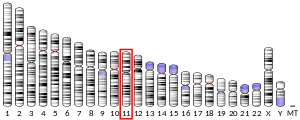| HEPN1 | |||||||||||||||||||||||||||||||||||||||||||||||||||
|---|---|---|---|---|---|---|---|---|---|---|---|---|---|---|---|---|---|---|---|---|---|---|---|---|---|---|---|---|---|---|---|---|---|---|---|---|---|---|---|---|---|---|---|---|---|---|---|---|---|---|---|
| Identifiers | |||||||||||||||||||||||||||||||||||||||||||||||||||
| Aliases | HEPN1, hepatocellular carcinoma, down-regulated 1 | ||||||||||||||||||||||||||||||||||||||||||||||||||
| External IDs | OMIM: 611641 HomoloGene: 134601 GeneCards: HEPN1 | ||||||||||||||||||||||||||||||||||||||||||||||||||
| |||||||||||||||||||||||||||||||||||||||||||||||||||
| |||||||||||||||||||||||||||||||||||||||||||||||||||
| |||||||||||||||||||||||||||||||||||||||||||||||||||
| Wikidata | |||||||||||||||||||||||||||||||||||||||||||||||||||
| |||||||||||||||||||||||||||||||||||||||||||||||||||
Hepatocellular carcinoma, down-regulated 1 is a protein that in humans is encoded by the HEPN1 gene. [3]
Function
This gene is expressed in the liver, and encodes a short peptide that is localized predominantly to the cytoplasm. Transient transfection studies showed that expression of this gene significantly inhibited cell growth, and it may have a role in apoptosis. Expression of this gene is downregulated or lost in hepatocellular carcinomas (HCC), suggesting that loss of this gene is involved in carcinogenesis of hepatocytes.[4] Also to note is that this gene maps to the 3'-noncoding region of the HEPACAM gene (GeneID:220296) on the antisense strand.[5]
References
- 1 2 3 GRCh38: Ensembl release 89: ENSG00000221932 - Ensembl, May 2017
- ↑ "Human PubMed Reference:". National Center for Biotechnology Information, U.S. National Library of Medicine.
- ↑ "Entrez Gene: Hepatocellular carcinoma, down-regulated 1". Retrieved 2017-09-12.
- ↑ Moh MC, Lee LH, Yang X, Shen S (2003). "HEPN1, a novel gene that is frequently down-regulated in hepatocellular carcinoma, suppresses cell growth and induces apoptosis in HepG2 cells". J Hepatol. 39 (4): 580–6. doi:10.1016/s0168-8278(03)00359-3. PMID 12971969.
- ↑ Chung Moh M, Hoon Lee L, Shen S (2005). "Cloning and characterization of hepaCAM, a novel Ig-like cell adhesion molecule suppressed in human hepatocellular carcinoma". J Hepatol. 42 (6): 833–41. doi:10.1016/j.jhep.2005.01.025. PMID 15885354.
Further reading
- Peng H, Fan J, Wu J, Lang J, Wang J, Liu H, Zhao S, Liao J (2013). "Silencing of HEPN1 is responsible for the aggressive biological behavior of pituitary somatotroph adenomas". Cell. Physiol. Biochem. 31 (2–3): 379–88. doi:10.1159/000343375. PMID 23548416.
- Kim HS, Jung G (2014). "Reactive oxygen species increase HEPN1 expression via activation of the XBP1 transcription factor". FEBS Lett. 588 (23): 4413–21. doi:10.1016/j.febslet.2014.10.011. PMID 25448679. S2CID 859229.
This article incorporates text from the United States National Library of Medicine, which is in the public domain.

